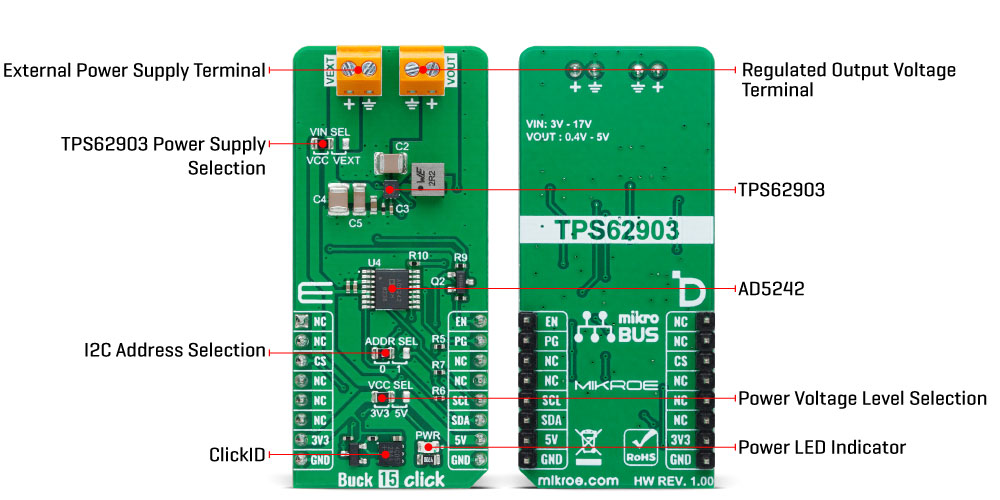OFF
GO LOCAL
| Company | Stock | Price |
|---|---|---|

MIKROE-6044
20 g
Status:
Buck 15 Click is a compact add-on board for precision voltage regulation across various applications. This board features the TPS62903, a synchronous step-down DC/DC converter from Texas Instruments. It is known for its adaptability, rapid transient response, and high output voltage accuracy of ±1.5% across all operating temperatures. Featuring the innovative DCS-control topology, it supports a wide input voltage range of 3V to 17V, an adjustable output voltage from 0.4V to 5V, and currents up to 3A. This Click board™ can be used in a variety of automotive applications, such as the ADAS, body electronics and lighting, infotainment and cluster, hybrid, electric, and powertrain systems, any application with a 12V input voltage or a 1-4 cell lithium battery pack, and more.
Buck 15 Click is fully compatible with the mikroBUS™ socket and can be used on any host system supporting the mikroBUS™ standard. It comes with the mikroSDK open-source libraries, offering unparalleled flexibility for evaluation and customization. What sets this Click board™ apart is the groundbreaking ClickID feature, enabling your host system to seamlessly and automatically detect and identify this add-on board.
This product is no longer in stock
Availability date:
OFF
| Company | Stock | Price |
|---|---|---|

Buck 15 Click is based on the TPS62903, a synchronous step-down DC/DC converter from Texas Instruments, recognized for its high efficiency, compact size, and adaptability. This converter stands out for its rapid transient response and supports a high output voltage accuracy of ±1.5% across the entire operating temperature range. It employs the DCS-control topology to enhance load transient performance, and its broad input voltage range accommodates various power sources, including 12V supply rails, single-cell or multi-cell Li-Ion batteries, and 5V or 3.3V power rails. Notably, the TPS62903 is designed to automatically enter power save mode under light load conditions, ensuring high efficiency and a low quiescent current of 4µA to optimize performance even at minimal loads.

Communication with the Buck 15 Click is conducted through a standard 2-wire interface linked to the AD5242, allowing the host MCU to adjust the output voltage. The device's I2C address is configurable via the ADDR SEL jumper, with a default setting of 0. This Click board™ also features a power-good (PG) pin that indicates when the output voltage falls outside the predetermined window threshold and an EN pin, which serves as a precision regulator-enable input.
Besides these pins, the TPS62903 also has a MODE/Smart-CONF pin, allowing for comprehensive customization of operational parameters such as the internal and external divider, switching frequency, output voltage discharge, and the mode of operation between automatic power save and forced PWM. An 11k R11 resistor setting achieves a 1MHz switching frequency, enabled output discharge, and Auto PFM/PWM Mode. The output voltage is adjustable from 0.4V to 5V, supporting currents up to 3A, enabled by an onboard digital potentiometer, the AD5242.
Buck 15 Click also offers versatile power sourcing options, allowing users to choose between internal and external supplies to suit their application needs best. This flexibility is achieved through the VIN SEL jumper, which enables users to select the VCC position for sourcing power internally via the mikroBUS™ power rails or the VEXT position to connect an external power supply. The external power supply can range from 3V to 17V, providing a broad voltage range for various project requirements.
This Click board™ can operate with either 3.3V or 5V logic voltage levels selected via the VCC SEL jumper. This way, both 3.3V and 5V capable MCUs can use the communication lines properly. Also, this Click board™ comes equipped with a library containing easy-to-use functions and an example code that can be used as a reference for further development.
Type
Buck
Applications
Ideal for ADAS, body electronics and lighting, infotainment and cluster, hybrid, electric, and powertrain systems, any application with a 12V input voltage or a 1-4 cell lithium battery pack, and more
On-board modules
TPS62903 - synchronous step-down DC/DC converter from Texas Instruments
Key Features
Qualified for automotive applications, wide input range from various power sources, adjustable output, support high power demands, high output voltage accuracy, high efficiency DCS-control topology, overcurrent and overtemperature protection, power good indicator, and more
Interface
GPIO,I2C
Feature
ClickID
Compatibility
mikroBUS™
Click board size
L (57.15 x 25.4 mm)
Input Voltage
3.3V or 5V,External
This table shows how the pinout on Buck 15 Click corresponds to the pinout on the mikroBUS™ socket (the latter shown in the two middle columns).
| Label | Name | Default | Description |
|---|---|---|---|
| LD1 | PWR | - | Power LED Indicator |
| JP1 | VCC SEL | Left | Power Voltage Level Selection 3V3/5V: Left position 3V3, Right position 5V |
| JP2 | VIN SEL | Left | TPS62903 Power Supply Selection VCC/VEXT: Left position VCC, Right position VEXT |
| JP3 | ADDR SEL | Left | I2C Address Selection 0/1: Left position 0, Right position 1 |
| Description | Min | Typ | Max | Unit |
|---|---|---|---|---|
| Supply Voltage | 3.3 | - | 5 | V |
| External Power Supply | 3 | - | 17 | V |
| Output Voltage Range | 0.4 | - | 5 | V |
| Maximum Output Current | - | - | 3 | A |
We provide a library for the Buck 15 Click as well as a demo application (example), developed using MIKROE compilers. The demo can run on all the main MIKROE development boards.
Package can be downloaded/installed directly from NECTO Studio Package Manager (recommended), downloaded from our LibStock™ or found on Mikroe github account.
Library Description
This library contains API for Buck 15 Click driver.
Key functions
buck15_set_vout This function sets the voltage output by using an I2C serial interface.
buck15_set_vset This function sets the wiper position for the output voltage settings by using an I2C serial interface.
buck15_enable_device This function enables the device by setting the EN pin to high logic state.
Example Description
This example demonstrates the use of the Buck 15 Click board™ by changing the output voltage.
void application_task ( void )
{
for ( buck15_vout_t vout = BUCK15_VOUT_0V6; vout <= BUCK15_VOUT_5V; vout++ )
{
if ( BUCK15_OK == buck15_set_vout( &buck15, vout ) )
{
log_printf( &logger, " Vout : %.1f [V]rn", vout_table[ vout ] );
log_printf( &logger, "____________rn" );
Delay_ms( 5000 );
}
}
}
The full application code, and ready to use projects can be installed directly from NECTO Studio Package Manager (recommended), downloaded from our LibStock™ or found on Mikroe github account.
Other Mikroe Libraries used in the example:
Additional notes and informations
Depending on the development board you are using, you may need USB UART click, USB UART 2 Click or RS232 Click to connect to your PC, for development systems with no UART to USB interface available on the board. UART terminal is available in all MIKROE compilers.
This Click board™ is supported with mikroSDK - MIKROE Software Development Kit. To ensure proper operation of mikroSDK compliant Click board™ demo applications, mikroSDK should be downloaded from the LibStock and installed for the compiler you are using.
For more information about mikroSDK, visit the official page.
NOTE: Please be advised that any peripheral devices or accessories shown connected to the Click board™ are not included in the package. Check their availability in our shop or in the YMAN section below.